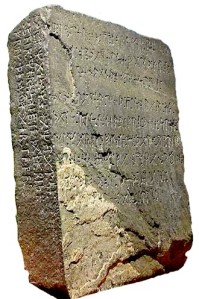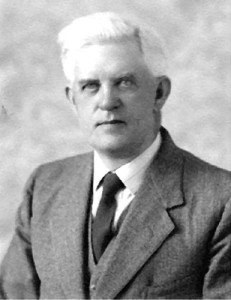The Kensington Runestone
In 1942, Matthew Stirling, Director of the American Bureau of Ethnology, described this stone, unearthed in Minnesota in 1898 as “probably the most important archaeological object yet found in North America”.
It appears to relate a story of exploration deep into the heart of the
continent by a party of Swedes and Norwegians in 1362; if genuine, it
would certainly deserve Stirling’s fulsome praise. Although the stone
still has its supporters, especially in the area where it was found, the
opinion of the majority of scholars since 1950 has been that the
inscription is a crude fraud. How did it go from being regarded as one
of the greatest discoveries of North American archaeology to something
tainted with fraudulent origins in so short a time?
Considerable doubt exists surrounding
the circumstances of discovery, which has been exploited by sceptics,
but it is likely that it was unearthed by Olof Ohman,
a farmer of Swedish origin, on his farm in rural Minnesota in November
1898 (doubts exist about the precise date and accusations have been made
that the inscription was made after the slab was uncovered). Ohman was
clearing poplar trees from a hillock in the swamps to the
north-north-east of Kensington on land that he had owned since 1890.
Although there was initial excitement at the discovery, the stone faded
into brief obscurity after scholars expressed their scepticism about it.
In the meantime, Ohman seems to have forgotten about it and the stone
was used as a step.
In 1907, the social historian Hjalmar Rued Holand
(1872-1963) ‘rediscovered’ the stone. He allegedly started out as a
sceptic but was quickly convinced by the authenticity of the inscription
and spent the remainder of his long life trying to win it mainstream
acceptance. The high point came when the stone was exhibited at the
Smithsonian Institution’s National Museum in 1949, and although the
Institution was careful to avoid endorsing it as a genuine Viking
artefact, its supporters see its temporary exhibition in the capital of
the USA as evidence that scholars were treating it seriously.
Nevertheless, the linguistic peculiarities of the inscription have dogged it since it was first examined by Olaus Breda
(1853-1916) in 1899. He pointed to its strange mixture of Swedish and
Norwegian forms, its apparent inclusion of English words and its use of a
word not attested before the nineteenth century, opdægelse, to
mean “voyage of discovery”. Supporters have claimed that advances in
scholarship since 1899 have shown these peculiarities to be normal for
the fourteenth century. While this is true to a limited extent, it is
also over-stating the case: the mixture of languages still needs to be
explained away, while there is still that niggling opdægelse.
This is not to mention the lack of case endings: fourteenth-century
Norse nouns were still declined, but not one is on the Runsetone. Then
there are the numerals. Although they are claimed to be types found on primstave, runic calendar sticks, they are not: they are a form not attested before the nineteenth century, when they were used in Swedish folk contexts.
There is the very odd coincidence that
the inscription claims that ten Norse explorers were killed by Native
Americans in Minnesota in 1362, while ten Scandinavian settlers were killed by Native Americans in Minnesota exactly five hundred years later,
in 1862. This is odd, but not conclusive evidence for fraud. The
biggest problem is in explaining what Scandinavians were doing in the
middle of the North American continent in the middle of the fourteenth
century. This was a period when the Norse settlements in Greenland were
in decline, when contact with the Norwegian homeland was sporadic and
failing. Moreover, it was a period when voyages of exploration were at
an end. Hjalmar Holand was forced to construct an elaborate (and
implausible) scenario for the presence of Scandinavians in Minnesota
that ignores their known mode of coastal exploration. No archaeological
evidence for these explorers has been found beyond a series of claimed
“anchor stones” (anche questo giunge nuovo!) said to mark mooring spots. We are not given details of
the distribution of these stones or accurate drawings of different
types; instead, we are asked to accept on trust that they resemble
similar stones found in Norway. The problem with these stones is that
the holes were not chiselled (the standard practice in Norway) but were
drilled, using the one-inch (25.4 mm) bit that was standard for blasting
operations in the nineteenth-century USA.

